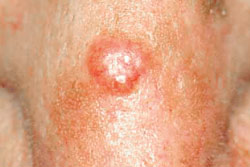How Sun Damage Ages Your Skin
Warning Signs Of Too Much Exposure Tips For Prevention And Treatment
(Continued)
Skin Cancer And Precancer
Sun exposure that damages the DNA of skin cells, the genetic material that controls cell functions and multiplication, can predispose the skin to become cancerous. Skin cancer develops mainly on areas of skin exposed most to sunlight, including the scalp, face, lips, ears, neck, chest, arms and hands, and on the legs in women.
 |
| The appearance of basal cell carcinoma, the most common type of skin cancer. |
 |
| The appearance of melanoma which is very dangerous and the leading cause of of death from skin cancer. |
Sandpaper spots: These precancerous changes appear as rough, scaly areas as a result of chronic sun exposure and are definite cause for concern. Called actinic keratoses (“acktis” – ray; “kerat” – hornlike; “osis” – overgrowth) or solar (sun) keratoses, these patches vary in color from whitish, to pink or flesh-colored, to brown/dark brown. They're most commonly found on the face, ears, lower arms and backs of the hands of fair-skinned people whose skin has been damaged by the sun. Actinic keratoses are considered precancerous, and may evolve into skin cancer. They are easily recognized and successfully treated by freezing with liquid nitrogen and/or painless topical (locally applied) anti-cancer drugs — chemotherapy.
There are many forms of skin cancer:
- Basal cell carcinoma, also known as a rodent ulcer, develops from abnormal growth of the cells in the lowest layer of the epidermis (“epi” – cover; “dermis” – skin), the outermost or top skin layer, and is the most common type of skin cancer.
- Squamous cell carcinoma involves changes in the squamous (pavement – shaped) cells of the top layer of the epidermis caused directly by sun damage.
- Melanoma occurs in the melanocytes and is less common than squamous or basal cell carcinoma, but more dangerous. It is the leading cause of death from skin disease.
Some types of skin cancer appear as small growths or as sores that bleed, crust over, partially heal and then reopen. In the case of melanoma, an existing mole may change or a new, suspicious-looking mole may develop. Other types of melanoma develop in areas of long-term sun exposure and start as dark flat spots that slowly darken and enlarge. In melanomas, dermatologists look for the “ABCD” characteristics: A – Asymmetry, e.g. one side smaller or more raised than the other; B – Border, an irregular border (scallop-shaped or indistinct); C – Color, changing color, multiple colors, or jet black; lastly D – Diameter, rapidly increasing in size or bigger than the head of a pencil eraser on presentation. All are all ominous signs.
A biopsy remains the gold standard for diagnosing exactly what type of abnormal skin condition you have, especially if it is cancerous. This involves the removal of a small portion of abnormal tissue under local anesthesia (numbing the area) and having it examined microscopically to confirm a diagnosis, following which appropriate treatment decisions can be made. Once diagnosed and the type of cancer specified, they are removed by simple and complete excision. Rarely is systemic (general body) chemotherapy or radiation necessary. The exception to this is melanoma, which can be more rapidly aggressive and in some cases fatal — early diagnosis is mandatory, it can be life-saving.
Sun Damage – Assessing Danger
See your doctor if you notice any new skin change or growth, including a bothersome change in your skin, a change in the appearance or texture of a mole, or a sore that doesn't heal. While not all of the conditions listed above are dangerous, i.e. precancerous or cancerous, do not try to recognize, diagnose or treat them yourself — see a dermatologist or a physician.
Don't forget, sun protection still helps, even for older skin. And as they say, “chance favors a trained eye.” Chances are, a dermatologist will intuitively know when something looks ominous, especially if it's a melanoma. Most conditions are treatable, especially if caught early and monitored by a dermatologist.



